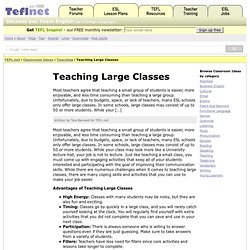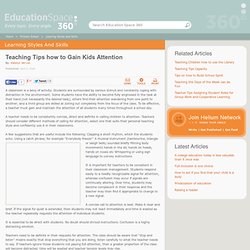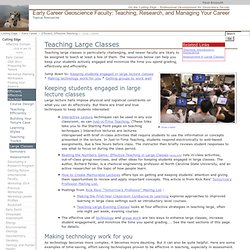

Teaching Large Classes. Most teachers agree that teaching a small group of students is easier, more enjoyable, and less time consuming than teaching a large group.

Unfortunately, due to budgets, space, or lack of teachers, many ESL schools only offer large classes. In some schools, large classes may consist of up to 50 or more students. While your […] Written by Tara Benwell for TEFL.net Most teachers agree that teaching a small group of students is easier, more enjoyable, and less time consuming than teaching a large group. I-to-i Chalkboard « Keywords: i-to-i, teaching large classes, TEFL, TESOL. Teaching English is a challenge, teaching large classes is the challenge of all challenges!

By large classes, I’m talking 30 students and above. In fact in the TEFL world, generally anything above 20 is regarded as large and unproductive. In an ideal world everyone would teach smaller classes so students get the attention they deserve (and for the peace of the teacher’s mind and sanity!) , but in some countries this is just not possible. So it’s our job being the ever so flexible and creative TEFL teachers that we are to make the best of what we have got. Here are some activities to point you in the right direction: 1. English Skills: Speaking, Listening, Vocabulary Objective: Communicate words without saying them. Www.onestopenglish.com/grammar/pdf-content/vocabulary-british-english/british-english-describing-people-2-worksheet-and-teachers-notes/147084.article.
Www.onestopenglish.com/grammar/pdf-content/vocabulary-british-english/british-english-personality-worksheet-1-and-teachers-notes-1/147110.article. Www.onestopenglish.com/community/lesson-share/pdf-content/speaking/speaking-first-class-mingle-teachers-notes/147653.article. Www.onestopenglish.com/community/lesson-share/pdf-content/grammar/grammar-personality-traits-teachers-notes/147602.article. Giving and Checking Instructions. Some of the activities that we use in the classroom are fairly complex in terms of the way they're organised, and I doubt if there are many teachers who can honestly claim that they've never got a class totally confused by the way they've given instructions.

How can you make sure that your instructions are as clear and comprehensible as possible? Sue Swift offers some guidelines... 1. Plan how you're going to give the instructions before you go into the classroom, and make sure that you can explain them within the limits of the language which the students can understand. For example, the following instruction would be fine for an intermediate class, but would lose a group of beginners: "You're going to hear a description of a famous person and you have to guess who it is. " 2. 3. 4. 5. 6. 7. A) at the beginning of the course, give the instructions in the L1, and then repeat them immediately, as simply as possible, in English. Does anyone know some good activities for large classes? - ESL Games and Activities. Hi, I teach very large classes as well, often with a massive range of levels, both in interest and ability.

I find that most of the whispering or relay games work really well with large groups because the more teams you have the stronger the competition. 1) For low level students line them up in teams of 5 or 6. Give the last student in each row the same word, and have them whisper it up to the front. The first class to either write the word on the board or tell it to the teacher wins. It forces kids to both speak clearly and listen carefully, as well as pay attention to that day's key phrases. Games for 5-9 year olds in large groups (20+) I've been teaching English to kindergarten and elementary school students for a year and a half now, and I've had a really hard time finding lesson and games ideas to use because of my situation - I teach nearly 3,000 students at 10 different schools, and only see my kids once a month if I'm extremely lucky (more often it's once every 2 months or in the worst cases once a semester) for 45-minute classes.

My students aren't learning English formally, so only the ones who take private lessons can read or even answer questions like "How are you? ", and generally they forget most everything from the previous lesson by the next time I see them. This is something I've had a really hard time dealing with, particularly when schools give me lesson plans like "Teach them the days of the week, to tell time, to say & answer 'What time do you get up? ", "Where do you want to go? ", etc. within the space of a single class. Teaching tips: How to gain kids attention - by Katelyn Vercoe. Katelyn Vercoe's image for: "Teaching Tips how to Gain Kids Attention" Caption: Location: Image by: A classroom is a bevy of activity.

A teacher needs to be consistently concise, direct and definite in calling children to attention. A few suggestions that are useful include the following: Clapping a short rhythm, which the students echo. It is important for teachers to be consistent in their classroom management. Large Classes. Teaching large classes is particularly challenging, and newer faculty are likely to be assigned to teach at least a few of them.

The resources below can help you keep your students actively engaged and minimize the time you spend grading, effectively and efficiently. Students in a large lecture hall at Wake Forest University's School of Medicine are actively engaged through technology. Photo from WFUSM's media photo website. Teaching English Tips to Stay in Control of a Large Class. What can we do to bring a rowdy class of children back into line?

Shelley Vernon shares some essential tips for controlling a large class... Teaching English with games is becoming standard through out ESL classrooms of the world. And this is good news, because children love to learn through games, and become much more motivated students as a result.